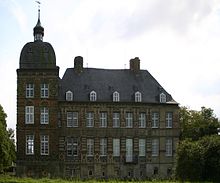Laurenz von Brachum
Laurenz of Brachum (* the first quarter of the 16th century in Wesel , † 1586 in Gelsenkirchen-Horst ) more rarely, Laurenz from Koldenberg called, was a German builder of the 16th century, the founder of the lip Renaissance was. In addition to his main work, Horst Castle in today's Gelsenkirchen , he built other castles and other buildings, especially on the Lippe and in the southern Münsterland .
Life
Laurenz originally came from Wesel and appeared in contemporary accounts as a stonemason , master mason and builder. He later obtained citizenship in Wiedenbrück . From September 23, 1558 he initially worked as a simple stone mason ( Steynhower ) on the construction of Horst Castle as the residence of the Elector of Cologne in Vest Recklinghausen . Through the local site manager Arn (d) t Johannssen to Becoep he got to know the style of the Fontainebleau school . The collaboration between the client Rütger von der Horst and Johannsen was evidently not free of conflict, from which Laurenz benefited. After he had already received the order in 1560 to design and build two courtyard-facing galleries , Rütger von der Horst increasingly involved him in the construction process. From 1563/64 the Weseler took over part of Johannsen's duties, after whose departure in 1567 he even rose to the position of chief master builder on the Horster palace construction site. This fact is remarkable in that von Brachum could neither read nor write. He therefore always signed the contracts concluded with him with his stone carving mark . Influenced by Dutch models, he used stylistic elements of the mannerism that arose in the Netherlands as a design element for the Horster castle facades. After this, his first major work, the Horst Castle in the ( Emscher ) Bruch, Laurenz called himself "von Brachum" since he moved from Wesel to the local castle construction site.
While he was still working in Horst, in September 1560 he accepted an offer from Franz von Loë to build what is now Haus Geist near Oelde for him . Between 1563 and 1572, on behalf of Goswin von Ketteler, the construction of Hovestadt Castle followed , who in 1564 also entrusted him with the construction of the Assen house . Horst acted as a model for all these castle buildings. In addition, von Brachum designed numerous other representative buildings. In 1575 this included the plans to expand the Arnsberg Castle into the residence of the Cologne Elector Salentin von Isenburg , the so-called Salentinbau . The old school building of the Archigymnasium in Soest also came from him.
Its special architectural style prompted the art historian Richard Klapheck to introduce the term Lipperenaissance at the beginning of the 20th century .
literature
- Franz Flaskamp: The Brachums. A Rhenish-Westphalian master builder family from the Renaissance and Baroque . In: Westphalia . No. 40, 1962, pp. 150-168.
- Richard Klapheck: The masters of Horst Castle in Broiche. The final chapter on the history of the school of Calcar . Wasmuth, Berlin 1915, pp. 81-84, 247-248 ( online ).
- Wolfgang A. Lewe and Christian Loefke: The Brachum family in Rheda and Wiedenbrück . In: Contributions to Westphalian family research. Volume 72/73, 2014/2015, ISBN 978-3-402-13893-9 , pp. 709-729.
- Siegfried Schmieder: Laurenz von Brachum - the builder of the Warendorf cathedral gate . In: Warendorfer Schriften . No. 21/24, 1991/1994, ISSN 1865-3006 , pp. 316-329.
- Laurenz von Brachum . In: General Artist Lexicon . The visual artists of all times and peoples (AKL). Volume 13, Saur, Munich a. a. 1996, ISBN 3-598-22753-1 , p. 512 f.
Web links
Individual evidence
- ↑ Klaus Gorzny: Lippe locks. Should there be locks on the lip? Piccolo, Marl 2004, ISBN 3-9801776-8-8 , p. 24 ( online ( memento of the original dated September 27, 2007 in the Internet Archive ) Info: The archive link was inserted automatically and has not yet been checked. Please check the original and archive link according to the instructions and then remove this notice. ).
- ^ Rainer A. Krewerth: Westphalia. Land of moated castles . Hörnemann, Bielefeld 1990, ISBN 3-928193-05-8 , p. 132.
- ↑ a b c d Wildtrud Apfeld: The historical development of Schloß Horst . In: Contributions to the Renaissance between 1520 and 1570 (= materials on art and cultural history in Northern and Western Germany . Volume 2). Jonas, Marburg 1991, ISBN 3-89445-113-0 , p. 55.
- ↑ Joseph Herold: The thousand-year history of the community Herzfeld . Schöningh, Paderborn and Münster 1886, p. 26 ( online ).
- ^ A b Carin Gentner: The Great Elector in Hovestadt Castle. Grand travel and dining in 17th century Westphalia , accessed May 11, 2013.
| personal data | |
|---|---|
| SURNAME | Brachum, Laurenz von |
| ALTERNATIVE NAMES | Koldenberg, Laurenz vom; Brachum, Laurentz van |
| BRIEF DESCRIPTION | Renaissance builder |
| DATE OF BIRTH | 16th Century |
| PLACE OF BIRTH | Wesel |
| DATE OF DEATH | 1586 |
| Place of death | Gelsenkirchen-Horst |

